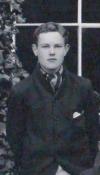
War Memorial
| Captain Guy Bertram Charles HOWARD | |
|
14th (Reserve) Battalion King’s Royal Rifle Corps attached to the 1st Battalion King’s Own Scottish Borderers and to the Royal Engineers Date of birth: 5th May 1887 Date of death: 6th January 1928 Died aged 40 Buried at Hove Cemetery |

|
| Guy Bertram Charles Howard was born in London on the 5th of May 1887 the eldest son of Charles William Howard, a ship owner and insurance broker, and Beatrice Emma (nee Holman) Howard of 109 Gloucester Terrace in London. He was christened at St Mary’s Church, Reigate on the 7th of June 1887. He was educated at Hazelwood School until July 1900 where he was a member of the Choir. He was a member of the 2nd Football XI in 1899 and of the Cricket XI in 1900. The school magazine wrote the following on his 1900 cricket season: - "Went all to pieces in his batting and seemed quite incapable of assimilating instruction. A useful bowler, when straight, and somewhat improved in the field." On leaving school the magazine wrote of him: - "....goes to Charterhouse. He was a member of the Cricket XI and a useful member of the choir. He has figured successfully before the footlights." He went on to Charterhouse School where he was in Hodgsonites House from September 1900 to December 1904. He worked for the firm of C. Howard & Sons, ship and insurance brokers, at Lloyds and the Baltic Exchange, of 45 Leadenhall Street EC London. He was elected as an Annual Subscriber at Lloyd's of London in 1899 and as an Underwriting Member of Lloyd's in 1914. He enlisted in the Inns of Court Officer Training Corps on the 11th of June 1908 and was honourably discharged on the 10th of June 1909. He was married in August 1914 to Gladys R. (nee Paul) and they lived at The "Leas", Sussex Square in Brighton. Following the outbreak of war he rejoined the Inns of Court Officer Training Corps on the 14th of September 1914 as Private A/1178. At a medical examination, which was held on the same day, it was recorded that he was five feet eleven and a half inches tall and weighed 145lbs. He was posted for training with A Company at Berkhamstead in Hertfordshire where he was promoted to Lance Corporal on the 23rd of October 1914. He applied for a commission in the 14th Battalion King's Royal Rifle Corps on the 9th of November 1914 and was commissioned as a 2nd Lieutenant in the battalion on the 18th of November 1914. He landed in Gallipoli on the 3rd of July 1915 where he was attached to the 1st Battalion King's own Scottish Borderers. On the 30th of July 1915 he left his unit having contracted cellulitis of the right elbow and dysentery. He was evacuated to hospital at Mudros on the 21st of August 1915. On the 23rd of August he was evacuated to England from Mudros Bay on board the HMT "Arcadian" and landed at Plymouth on the 9th of September. On his recovery he was put on “light duty” at Seaford and was declared as fit for general service by a Medical Board at Sheerness on the 26th of January 1916. On the 16th of November 1916 a Medical Board sat at Caxton Hall which recorded: - "The Board find that as the date and at the place recorded he fell down injuring his right elbow and causing a wound 1/2 inch long. He has since been bothered by diarrhoea since Sept 1st which is now better. His general health is satisfactory. The wound is healing" He transferred to the Royal Engineers and was posted to France where he was injured while in action on the 15th of January 1917. He was evacuated to England where a Medical Board sat to report on his case: - "Whilst in France in January 1917 he slipped and put out the semiluner cartilage. He was taken to Duchess of Westminster's Hospital and from there transferred to England. He was operated on and the cartilage removed in Feb. 1917 at Sussex Lodge, Regents Park." On the 19th of April 1917 he was ordered to report for duty with the Inland Water Transport Department at the War Office until such time as he was fit for general service. On the 19th of December 1918 a Medical Board sat at Sandwich Military Hospital which declared that he was permanently unfit for general service but was fit for garrison duty overseas. He was demobilised at No. 1 Dispersal Unit at Wimbledon on the 8th of January 1919. He served as Chairman of the Baltic Mercantile and Shipping Exchange from 1919 to 1922. From 1919 to 1925 he served as Hon Secretary of the Lloyd's Golf Club and was later elected as their Captain. He suffered severe injuries when he fell from cliffs at Kemp Town from which he never fully recovered and he died at a nursing home at 12 Dyke Road in Brighton. His funeral was held at 3pm on the 10th of January 1928 followed by a burial. |
|
| Went on to Charterhouse School |
Back